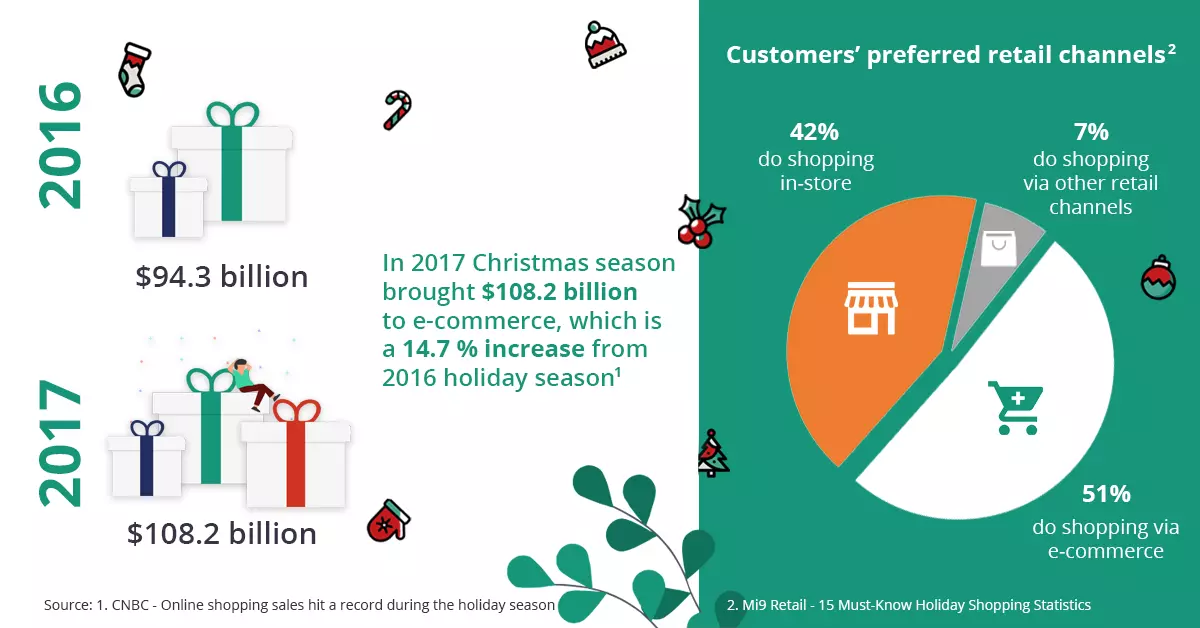Get your e-commerce ready for Christmas. Boost your conversion!
 Nina Suwaj
Nina Suwaj
Last Christmas, I gave you my heart… We all know how that goes, and as Holidays seems to be far into the future, it’s time to prepare for the upcoming shopping season.
Actually, last Christmas customers gave not the hearts but record number of $108.2 billion to e-commerce, which is a 14.7 per cent increase from 2016 holiday season (Source: CNBC). This period is crucial for online stores - 51% of customers choose shopping via e-commerce, 42% - in-store, and the remaining 7% through retail channels (Source: Mi9 Retail). The crushing statistics mentioned above show the global buying trends that every marketer or online store’s owner should acknowledge. Catch the opportunity for outstanding revenue.

E-commerce statistics. Source: 1. CNBC 2. Mi9 Retail
We’ll ride a sledge through the key aspects you should focus on starting from today. We’re glad to show you our threefold approach. Hop on to find out how to prepare e-commerce for Christmas 2018!
Website
Your online store has to run smoothly - no matter how you’ll promote your products, if the platform won’t work correctly, you’re not going to succeed in a sale. Bugs, slow website performance, unintuitive shopping path and other errors can force your potential customers to resign from purchasing. For shoppers time is crucial. Online shopping supposed to be convenient, fast and easy. Remember - happy customers will always come back. Especially before the Christmas season, which is an increased traffic period, to compete with other e-commerce, you have to make sure your website is in topnotch shape!
Test, test, test…
Test your online store in every possible way. Use free online tools like GTmetrix, Google PageSpeed Insights or WP Checkup. They can guide you which aspects need improvement. For example, you might need to optimise images, prioritise visible content, enable compression, improve server response time, specify a cache validator or minify CSS/ HTML/ JavaScript. Moreover, a good idea could be asking your friends (or Internet users - maybe on some e-commerce Facebook groups) for user experience evaluation. Customer path should be easy to follow without any disruptions. Make sure every button is visible, and the most used functions are highlighted enough. Mobile friendly e-commerce is a must-have nowadays. People are busy, and they deal with shopping in the meantime of other activities. Optimise your store for mobile users to get orders. This year more than 63% of U.S. online customers used mobile for shopping (Source: Statista). Don’t underestimate clients who buy via phones and tablets.
Update an online store
Improve your website, including images and product descriptions. The more information you’ll give, the better. Shoppers need to know what they’re buying. Does your platform suggest recommendations? Show your visitors what they can match with already chosen items. Maybe some clothes go in a set? Or particular colours fits together and are in trends this season? Check twice (or more) your store’s stock availability. You don’t want to disappoint your clients with a lack of desired products.

An example of great product description. Source: Zalando
Reviews
Find out if your e-commerce and products have positive reviews. If you haven’t done it before - respond to negative ones and improve the flaws. If you don’t have enough reviews, consider some additional actions to engage customers to write your opinions. Remind your clients about this critical step (highlight the fact that you need feedback to correct errors) and consider a reward system for giving a review.
Customer service
Around holidays time is going to be busy! Make sure you’re prepared for accelerated traffic on your website and professional and instant customer service. Maybe think about setting up a chatbot? Today’s customers expect the highest level of support. Be kind and helpful. Treat your clients like you’d like to be treated. Don’t let the lack of time to impact this process. If you use a chatbot, test it a few times to be confident about its functionalities. Customers are very impatient when it comes to conversation with bots (some of them don’t even realise they talk with a machine, so they got even more frustrated if the bot is wrongly programmed).
Cybersecurity
This period characterises intensified consumption. Customers know that e-commerce owners know that and also hackers know that. Therefore, take care of cybersecurity. Are you up to date with GDPR? Do you secure customers’ data? Are the payment methods secure enough? Set up a system which can detect suspicious activity, as several purchases proceed by the same person who’s using different credit cards. Train your employees to not send sensitive data via insecure messengers. Monitor your website frequently to provide the best possible service.
Xmas mood
Christmas is a very special time for many people. The magical, family atmosphere is spreading around streets offices and shopping centres. E-stores also can benefit from getting more Christmas-looky, but don’t go all crazy, add subtle decorations and only if they suit your website. Make it classy! You should consider some special offers and free shipping and returns. Research your competitors and level up to them if needed so that you won’t stand out from them.
Social media
While your website is ready for Christmas, it’s time to design a social media strategy. They can not only help you build a community focused on your brand, improve image and trust, but also promote and sell products.
Why it’s important (Source: Bigcommerce)?
32% more sales on average have e-stores that post on social media than stores that don’t.
4.55 posts a week on average are published by online shops on their Facebook page.
8% each month on average is growing the e-commerce site’s Facebook community.

E-commerce in Social Media. Source: Bigcommerce
So, how to optimise social media before Christmas shopping fever?
Create an extraordinary strategy
It’s an unusual period, so your communication in social media also supposed to be outstanding. Prepare unique content, maybe some graphics innovations to appeal to potential customers. Take a human face and show your team. Build a nice, friendly atmosphere on your page. Schedule posts for the day and time you think your customers can be interested in shopping. Don’t turn your feed in shopping website. Your strategy should combine product posts and other types of posts, which can engage your community. Consider organising a contest to engage even more and prepare some special gifts for your fans.
Improve customer service
As mentioned before, through December you might need additional support for your clients. Provide the best service to get positive reviews by satisfied consumers. Let them know about other benefits like free shipping and return. Ask them to contact you if they have any concerns about shopping.
Track conversion
Use Facebook’s pixel for remarketing (Facebook provides simple instruction, so it’s easy to implement pixel, a fragment of code, to your website). Remind customers about abandoned cart or products added to a wishlist. Thanks to the pixel you can create custom audiences and direct tailored ads especially for them.

Source: Facebook Business Manager
Shop section
Add or update products to this section. Make sure every information is correct so you won’t mislead your fans. This way you can redirect your clients to a particular page of your e-commerce. In your posts, you can tag these products, which is helpful for clients.
Don’t focus only on Facebook; there are few other platforms designed perfectly for e-commerce. Instagram is a continually growing platform; its’ users are mostly young, and they use new technologies on an everyday basis, so probably they’re eager to shop online.
Content marketing
To sell products and create your image as an expert in the field content marketing is essential. Design special content at your blog to attract customers. Think of consumers’ problems that you can solve and turn it into a blog post.
How to find the best topics for content marketing?
In this step, you should use online tools for the support. Answer the Public can tell you in what context Internet users are searching for your brands, products etc. Thanks to Buzzsumo you can analyse what content performs best for any topic or competitor. This way you can identify key influencers and promote your content. It’s also great for benchmarking - get inspired but don’t copy! Moreover, think of special content which can be useful before holidays for various types of audience. For example: „Christmas gift for boyfriend - 9 ideas”. Optimise every article for SEO goals.
How to distribute content?
Use social media to spread your article but think of the creative forms. Prepare animation, maybe an infographic or some highlights and optimise content for different social media platforms. Don’t forget about other ways to promote your blog. An effective could be e-mail marketing and web push notifications (try out PushPushGo to create and run marketing automation campaigns.

Start testing for free! Send your first holiday web push campaign already now!
Check an example of web push holiday campaign and how it looks on different operation systems). Both of those methods have to be used wisely. Don’t spam customers - notice that your client is probably subscribed for more than one e-commerce newsletters or notifications. Don’t be intrusive and don’t try only to sell. If your e-mail is about an article, don’t squeeze product ads. Content marketing will pay off in a long-run and only while it goes along gentle, customer-friendly communication.

Web push notification holiday campaign. View on Linux system. Source: PushPushGo

Web push notification holiday campaign. View on Windows system. Source: PushPushGo

Content Designer @Brainy Bees
Marketing and new technologies enthusiast. Krakow's University of Science and Technology graduate. Gained her experience in interactive agencies. Loves challenges and adventures, not only at work!
Try PushPushGo to engage and connect with your audience.
Create an account and start testing!





